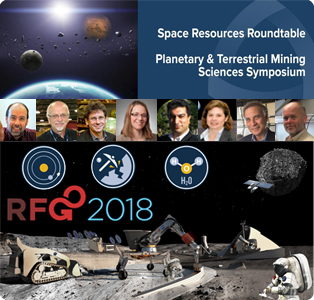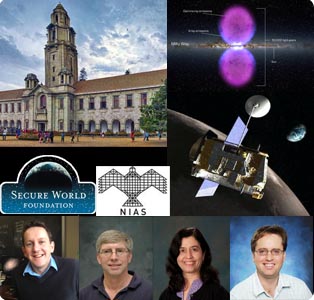SRR/PTMSS and CIM Meetings in USA, Canada Look Toward Resource Identification, Extraction, Ownership
|
MONDAY Ongoing…
|

![]() = All times
= All times
for terrestrial events in local time unless noted.
![]() = All times for international terrestrial events in local time unless noted.
= All times for international terrestrial events in local time unless noted.
![]() = All times for space events, and…
= All times for space events, and…
![]() = All times for international space / astro events in Hawaii Standard Time unless noted. Add 10 hours to obtain UT (‘Universal Time’).
= All times for international space / astro events in Hawaii Standard Time unless noted. Add 10 hours to obtain UT (‘Universal Time’).
Weekly Planet Watch – Evening Planets: Venus (WNW), Mars (S), Jupiter (SE); Morning Planets: Saturn (SE), Neptune (ESE).
Space Situational Awareness Workshop and Bubbles Big & Small Conference in Bengaluru, India Focuses on International Cooperation
Secure World Foundation and National Institute for Advanced Studies to host 2-day Space Situational Awareness: Strategic Challenges for India at JRD Tata Auditorium in Bengaluru June 14-15. Experts from around the world will gather to discuss government and commercial space economy, programs, and data sharing initiatives. Other topics include trends and capabilities in space domain, globalization of technology, commercial growth, and strategic challenges. Over 22,000 and increasing human-made objects are tracked in Earth orbit, including ~300 operational satellites in LEO and GEO, which makes space situational awareness a high priority to prevent collisions amid growing number of countries and commercial enterprises set on space exploration. ISRO Chairman K. Sivan is on the advisory committee while P. Sreekumar of IIA and Brian Weeden of SWF are on the organizing committee. The Indian Institute of Science Department of Physics and Raman Research Institute is hosting Bubbles Big & Small: From Supernovae & the Fermi Bubble to the Circumgalactic Medium conference June 11-14. With focus on observational developments, models, and theoretical understanding of circumgalactic medium. Discussions include black holes, interstellar and intergalactic medium, star development, and galaxy formation in addition to 5 poster participants. (L-R) Andrew Fox of Space Telescope Science Institute, Norman Murray of University of Toronto, Smita Mathur of Ohio State University, and Roland Crocker of Australian National University are among 28 scheduled speakers from ~10 countries. (Image Credits: SWF, NIAS, ISRO, IISci, Times of India, NASA, STSI, University of Toronto, Ohio State University, Australian National University) |
Continued from…
|
![]() Jun 4-15 — Mainz Institute for Theoretical Physics, Johannes Gutenberg University, Mainz, Germany: Program: The Sound of Spacetime – The Dawn of Gravitational Wave Science
Jun 4-15 — Mainz Institute for Theoretical Physics, Johannes Gutenberg University, Mainz, Germany: Program: The Sound of Spacetime – The Dawn of Gravitational Wave Science
![]() Jun 8-22 — Vesta: Peak viewing of protoplanet and second largest body in Main Asteroid Belt; will be visible by naked eye before Moonrise.
Jun 8-22 — Vesta: Peak viewing of protoplanet and second largest body in Main Asteroid Belt; will be visible by naked eye before Moonrise.
TUESDAY
![]() Jun 12-13 — Johns Hopkins University, Zanvyl Krieger School of Arts & Sciences, Morton K. Blaustein Department of Earth and Planetary Sciences, Baltimore MD: 50th Anniversary Symposium: Earth & Planetary Sciences – From Past to Future.
Jun 12-13 — Johns Hopkins University, Zanvyl Krieger School of Arts & Sciences, Morton K. Blaustein Department of Earth and Planetary Sciences, Baltimore MD: 50th Anniversary Symposium: Earth & Planetary Sciences – From Past to Future.
![]() Jun 12-14 — University of Tennessee Knoxville, Knoxville TN: Planetary Geologic Mappers Annual Meeting (#pgm2018).
Jun 12-14 — University of Tennessee Knoxville, Knoxville TN: Planetary Geologic Mappers Annual Meeting (#pgm2018).
![]() Jun 12-15 — Space Resources Roundtable, Planetary & Terrestrial Mining Sciences Symposium, Colorado School of Mines, LPI, Lunar Exploration Analysis Group, et al, Golden CO: 9th Joint SRR / PTMSS Meeting 2018 and Lunar Polar Prospecting Workshop; in conjunction with Lunar Polar Prospecting Workshop; focusing on ISRU activities for Moon, Mars, and asteroids from space agencies, private sector, academic institutions, and from recent legislation introduced for space-resource commercial exploitation.
Jun 12-15 — Space Resources Roundtable, Planetary & Terrestrial Mining Sciences Symposium, Colorado School of Mines, LPI, Lunar Exploration Analysis Group, et al, Golden CO: 9th Joint SRR / PTMSS Meeting 2018 and Lunar Polar Prospecting Workshop; in conjunction with Lunar Polar Prospecting Workshop; focusing on ISRU activities for Moon, Mars, and asteroids from space agencies, private sector, academic institutions, and from recent legislation introduced for space-resource commercial exploitation.
![]() Jun 12 — Moon: 1.2° N of Aldebaran, 13:00.
Jun 12 — Moon: 1.2° N of Aldebaran, 13:00.
WEDNESDAY
![]() Jun 13 — Nuclear Spectroscopic Telescope Array (NuSTAR), LEO: NASA satellite investigating black holes a billion times more massive than Sun, how particles are accelerated to very high energy in active galaxies & elements in supernova remnants enters 7th year of operations in space today; launched 2012.
Jun 13 — Nuclear Spectroscopic Telescope Array (NuSTAR), LEO: NASA satellite investigating black holes a billion times more massive than Sun, how particles are accelerated to very high energy in active galaxies & elements in supernova remnants enters 7th year of operations in space today; launched 2012.
![]() Jun 13-14 — SBAG, NASA, College Park MD: 19th Small Body Assessment Group; to identify scientific priorities and opportunities for exploration of asteroids, comets, interplanetary dust, small satellites, Trans-Neptunian Objects.
Jun 13-14 — SBAG, NASA, College Park MD: 19th Small Body Assessment Group; to identify scientific priorities and opportunities for exploration of asteroids, comets, interplanetary dust, small satellites, Trans-Neptunian Objects.
![]() Jun 13-15 — European Space Astronomy Centre (ESAC), Madrid, Spain: XMM-Newton 2018 Science Workshop: Time-Domain Astronomy: A High Energy View; at Villafranca del Castillo.
Jun 13-15 — European Space Astronomy Centre (ESAC), Madrid, Spain: XMM-Newton 2018 Science Workshop: Time-Domain Astronomy: A High Energy View; at Villafranca del Castillo.
![]() Jun 13 — Moon: New Moon, 09:44.
Jun 13 — Moon: New Moon, 09:44.
![]() Jun 13 — Mercury: 0.81° N of M35 cluster, 11:00.
Jun 13 — Mercury: 0.81° N of M35 cluster, 11:00.
THURSDAY
![]() Jun 14 — ISS, U.S. EVA #51, 405-km LEO: Expedition 55 members Ricky Arnold and Drew Feustel to perform 6.5-hour spacewalk starting 08:00 EDT to install HD camera and other maintenance activities – it will mark the 211th EVA at ISS overall; live coverage available.
Jun 14 — ISS, U.S. EVA #51, 405-km LEO: Expedition 55 members Ricky Arnold and Drew Feustel to perform 6.5-hour spacewalk starting 08:00 EDT to install HD camera and other maintenance activities – it will mark the 211th EVA at ISS overall; live coverage available.
![]() Jun 14 — Orbital ATK, Launch Pegasus XL / ICON, Kwajalein, Marshall Islands: Orbital ATK Pegasus XL rocket to launch NASA Ionospheric Connection Explorer (ICON) satellite into orbit.
Jun 14 — Orbital ATK, Launch Pegasus XL / ICON, Kwajalein, Marshall Islands: Orbital ATK Pegasus XL rocket to launch NASA Ionospheric Connection Explorer (ICON) satellite into orbit.
![]() Jun 14-15 — Secure World Foundation, National Institute for Advanced Studies, Bengaluru, India: Space Situational Awareness: Strategic Challenges for India; interdisciplinary experts gather from around the world to discuss governmental and commercial capabilities and initiatives.
Jun 14-15 — Secure World Foundation, National Institute for Advanced Studies, Bengaluru, India: Space Situational Awareness: Strategic Challenges for India; interdisciplinary experts gather from around the world to discuss governmental and commercial capabilities and initiatives.
![]() Jun 14 — Moon: 3.8° S of M35 cluster, 01:00; 4.6° S of Mercury, 04:00; at perigee (distance 359,133 km), 13:53.
Jun 14 — Moon: 3.8° S of M35 cluster, 01:00; 4.6° S of Mercury, 04:00; at perigee (distance 359,133 km), 13:53.
![]() Jun 14 — Apollo Asteroid 2018 LD1: Near-Earth Flyby (0.004 AU)
Jun 14 — Apollo Asteroid 2018 LD1: Near-Earth Flyby (0.004 AU)
FRIDAY
![]() Jun 15 — `Imiloa Astronomy Center, University of Hawai’i at Hilo, Hilo HI: Maunakea Skies Talk; astronomers from Very Long Baseline Array (VLBA) discuss research, recent discoveries and science; 19:00.
Jun 15 — `Imiloa Astronomy Center, University of Hawai’i at Hilo, Hilo HI: Maunakea Skies Talk; astronomers from Very Long Baseline Array (VLBA) discuss research, recent discoveries and science; 19:00.
![]() Jun 15-17 — A&E Television Networks, Mischief Management, Pasadena CA: AlienCon 2018; thought-provoking original programming, celebrity appearances, exhibits.
Jun 15-17 — A&E Television Networks, Mischief Management, Pasadena CA: AlienCon 2018; thought-provoking original programming, celebrity appearances, exhibits.
![]() Jun 15 — Moon: 11.5° S of Castor, 08:00; 7.8° S of Pollux, 12:00.
Jun 15 — Moon: 11.5° S of Castor, 08:00; 7.8° S of Pollux, 12:00.
![]() Jun 15 — Apollo Asteroid 2018 LK: Near-Earth Flyby (0.020 AU)
Jun 15 — Apollo Asteroid 2018 LK: Near-Earth Flyby (0.020 AU)
![]() Jun 15 — Aten Asteroid 2004 LO2: Near-Earth Flyby (0.064 AU)
Jun 15 — Aten Asteroid 2004 LO2: Near-Earth Flyby (0.064 AU)
SATURDAY
![]() Jun 16 — 55th Observation of the 1st Woman in Space, Global: Public events and commemorations occur to celebrate the first female to fly in Space, Valentina Tereshkova of the former Soviet Union – in 1963 she orbited Earth 49 times in Vostok 6, today 61 women have been in Space.
Jun 16 — 55th Observation of the 1st Woman in Space, Global: Public events and commemorations occur to celebrate the first female to fly in Space, Valentina Tereshkova of the former Soviet Union – in 1963 she orbited Earth 49 times in Vostok 6, today 61 women have been in Space.
![]() Jun 16 — AIAA San Francisco Section, Alameda CA: Annual Banquet on the USS Hornet; celebrating US Navy aircraft carrier USS Hornet which picked up the crew of Apollo 11 from Pacific waters; starts 17:00.
Jun 16 — AIAA San Francisco Section, Alameda CA: Annual Banquet on the USS Hornet; celebrating US Navy aircraft carrier USS Hornet which picked up the crew of Apollo 11 from Pacific waters; starts 17:00.
![]() Jun 16-17 — Space Generation Advisory Council, Vienna, Austria: Space Generation Forum 2.0.
Jun 16-17 — Space Generation Advisory Council, Vienna, Austria: Space Generation Forum 2.0.
![]() Jun 16-21 — Canadian Institute of Mining, Metallurgy and Petroleum, Geological Association of Canada, Vancouver, British Colombia, Canada: Conference: Resources for Future Generations 2018.
Jun 16-21 — Canadian Institute of Mining, Metallurgy and Petroleum, Geological Association of Canada, Vancouver, British Colombia, Canada: Conference: Resources for Future Generations 2018.
![]() Jun 16 — Moon: 2.3° S of Venus, 03:00; 1.2° S of Beehive Cluster, 10:00.
Jun 16 — Moon: 2.3° S of Venus, 03:00; 1.2° S of Beehive Cluster, 10:00.
![]() Jun 16 — Apollo Asteroid 2018 LF1: Near-Earth Flyby (0.040 AU)
Jun 16 — Apollo Asteroid 2018 LF1: Near-Earth Flyby (0.040 AU)
![]() Jun 16 — Aten Asteroid 469737 (2005 NW44): Near-Earth Flyby (0.055 AU)
Jun 16 — Aten Asteroid 469737 (2005 NW44): Near-Earth Flyby (0.055 AU)
![]() Jun 16 — Apollo Asteroid 2018 BC: Near-Earth Flyby (0.071 AU)
Jun 16 — Apollo Asteroid 2018 BC: Near-Earth Flyby (0.071 AU)
![]() Jun 16 — Aten Asteroid 2014 GQ17:Near-Earth Flyby (0.086 AU)
Jun 16 — Aten Asteroid 2014 GQ17:Near-Earth Flyby (0.086 AU)
SUNDAY
![]() Jun 17 — Roscosmos, Launch Soyuz / Glonass M, Plesetsk Cosmodrome, Russia: Russian government Soyuz rocket 2-1b configuration with a Fregat upper stage to launch Glonass M navigation satellite.
Jun 17 — Roscosmos, Launch Soyuz / Glonass M, Plesetsk Cosmodrome, Russia: Russian government Soyuz rocket 2-1b configuration with a Fregat upper stage to launch Glonass M navigation satellite.
![]() Jun 17 — Moon: 1.6° NNE of Regulus, 23:00.
Jun 17 — Moon: 1.6° NNE of Regulus, 23:00.

